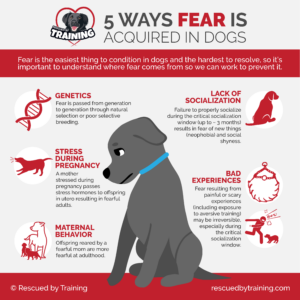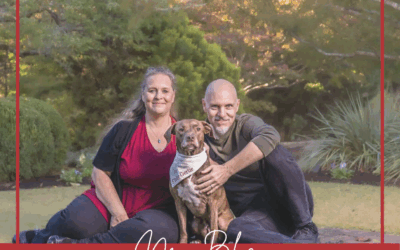Adopting a fearful dog from a puppy mill, hoarding situation or backyard breeder dog can be incredibly rewarding and very challenging. There’s something to helping a fearful dog blossom into a confident, non-fearful dog. But, I get a lot of clients who are not prepared for the amount of work involved in helping these dogs. Part of that could be lack of transparency from the rescue or shelter or people just being told “dogs just need love,” when really, dogs like this need so much more than love to overcome fear issues.
Telling others that their fearful dog “just needs love” to get better, may be well-meaning but it’s grossly mistaken, and could contribute to them not getting the help they actually need. This is akin to telling someone with a fractured leg that they just need love to heal their fracture. And yes, while there are degrees of fracture severity, like there are degrees of fearful dogs, all broken legs need some type of medical care for proper healing and long term recovery. While a very simple fracture may only require a brace, ice and rest, other, more complicated fractures require an orthopedic surgeon, pins, plates, medication and extensive physical therapy, Regardless of the type of fracture, an assessment by a professional to make a determination of severity and create plan for recovery is required. But often, just like in human medicine, mental health issues or pain you cannot see is discounted or minimized. You would never tell someone with a broken leg that they just need love to heal. And we shouldn’t minimize the suffering fearful dogs have either.
Sure, dogs need time to decompress and settle into a new environment but fearful dogs won’t just “get over” being fearful. They need training, and often medication, to help them be less anxious and able to learn the things we’re trying to teach them. They need help, not just love. For many of these dogs, the last thing they want is more attention, doting or touching, because people or kids are scary to them.
 Fear comes from several sources in dogs. Download my free 5 Ways Fear Is Acquired In Dogs here.
Fear comes from several sources in dogs. Download my free 5 Ways Fear Is Acquired In Dogs here.
Fear can be passed genetically through poor selective breeding. No good breeder would knowingly continue to breed fearful parents, especially a fearful female. So we see fearful genetics commonly in dogs coming from bad breeders like in puppy mills, backyard breeders, street dogs/strays (like Sato dogs from Puerto Rico, Desi/Indian street dogs) and those from meat markets, which are really raised more like livestock than domesticated dogs.
Why is this important? Sound sensitivity, including to thunder, gunshots, fireworks, balloons popping, cars backfiring and other similar noises, is genetic in dogs, as is a tendency to be harder to socialize. This is why I always recommend meeting mom if she’s available when you’re getting a puppy. If mom is fearful or not particularly friendly and social, chances are very good, your puppy will have this trait as well.
Fear can also come from maternal stress and behavior, so in a puppy mill, mom is very likely to be stressed, and that impacts the puppies. And lack of socialization and bad experiences also play into a dog’s fears. Puppy mill dogs are not well socialized during their critical socialization window (up to the 12 weeks of age) and often miss out on opportunities for really formative skills like puppy play, reading dog body language, dog communication and acquiring bite inhibition.
So what do you need to know if you’re adopting a dog like this?
- They will likely be fearful, for all the reasons listed above. They don’t just need love. They need real training with a qualified, force-free trainer (like me!) who understands how to help fearful dogs. You should not attempt to flood them with socialization or things they’re afraid of and hope “they get used to it.” This approach will likely make fears worse, not better.
- Do no harm. This means using only kindness and force free training methods and going at your dog’s pace, even if it feels slow to you. This is how you will gain your dog’s trust. Forcing a dog to do things or trying to coax them when they’re fearful isn’t the best way to approach things. Even things that feel like they’re correct, like hand feeding a fearful dog isn’t recommended. Read why I don’t suggest hand feeding fearful dogs here.
- Puppy mill dogs often struggle with house training more than other dogs. They sometimes will eat their feces, in an attempt to keep their space clean, since dogs are generally pretty fastidious about clean areas.
- They will often struggle with confinement more than other dogs. Having spent all or most of their lives in wire crates, being confined to a crate or sometimes even a larger confinement area can be a struggle, which also can contribute to the difficulty in house training them.
- They may struggle with being touched, cuddled or at the vet. One of the critical skills we can teach during the early socialization window is body handling – grooming, vetting, human touch…that those things don’t have to be scary. If a dog was roughly handled or not handled at all during this critical window, they likely will have fears and may snap or bite when handled.
- They may resource guard items, whether from genetics, scarcity or competition with other dogs for things like food.
- They may develop separation anxiety. Having been deprived of human contact, some dogs will very strongly bond to their people and panic when left alone. You didn’t create this problem but you should know what not to do, so you don’t make it worse. Learn what not to do if you think your dog has separation anxiety and consider my self-paced course, Separation Anxiety Foundations.
- Puppy mill dogs may need a slower introduction to other pets at home. Sometimes puppy mill dogs thrive with the company of another dog. Some fearful dogs are helped by having another dog around while others may struggle with other pets. Learn how to integrate new pets here.
- Your dog may growl if they’re afraid. And they should. That’s how they communicate they’re afraid and to try to make that scary thing go away. Read here what to do if your dog growls.
- Your dog may be afraid of outside, whether due to noises, all the activity (especially if you live in a city) or from lack of socialization. Never force walks. If your dog is afraid of outside, consider my self-paced course, Conquering The Urban Jungle.
- Puppy mill dogs may not be socialized to children. All dogs should be carefully supervised around children but due to lack of socialization and fear issues, puppy mill dogs may be more likely to be afraid of kids, toddlers, crying babies and the unpredictable nature of kids in general.
How can you help them?
- They need to feel safe and not put into scary situations.
- They need owners who understand how to read dog body language and communication so they’re not pushed into unsafe situations. (download my free Dog Communication handout here)
- They need owners who understand dogs don’t bite or behave “unprovoked.” There’s always a reason.
- They need owners who will work with a qualified behavior consultant to learn how to modify behavior, not just suppress it.
- They need owners who understand the dog determines what is safe or unsafe, not the owner.
- They need owners who will move at the dog’s pace, not the human’s pace.
- They need owners who understand progress will be slow and who are OK with that.
- They need owners who will commit to never using aversive, painful tools or training methods (like prong, choke, shock collars) or any “corrections” including yelling, scolding, saying NO in a “firm” voice, leash jerking, alpha rolling or “tssssst”-ing. These methods have fallout effects, even if they look like they’re working.
- They often need pharmaceutical medication, not woo-woo “natural” remedies that haven’t been studied, tested, approved and that are unregulated, so we know nothing about dosing, interactions with other medications or what’s actually in these products.
Here are some other links to helpful fearful dog posts:
- Behavioral Medication In Training
- No, Is Not A Behavior
- Behavior Suppression Versus Behavior Modification
- 5 Mistakes You’re Making With Your Fearful Dog
- Fearful Dogs and Hand Feeding
- Fear In Dogs series
If you need help with your fearful or anxious dog, schedule your one on one session here! And be sure to sign up for my free weekly newsletter so you don’t miss out on free tips, videos, personal stories, client successes and more!
Happy training!
![]()




